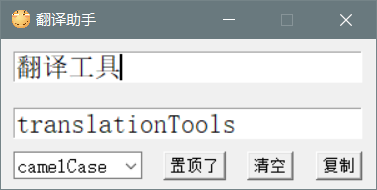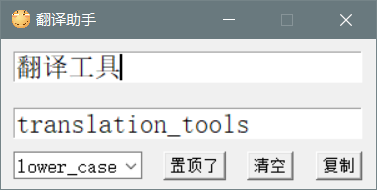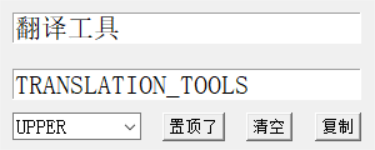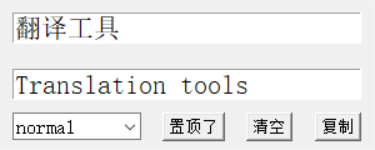python实现函数变量命名翻译工具 源码及工具下载
2020-07-14 06:11
274 查看
介绍
如题,为了解决一命名就词穷的问题,想搞一搞命名工具,正好刚接触python(2019年冬),就练练手,顺便爬一下有道翻译(爬有道翻译网上有教程,一搜一把,但我这个是最简单的版本),先看下效果。





大概就是这么个鬼东西,丑了点,但是我用了大半年,呵呵呵呵呵呵。。。然后有了他的升级版,详情请看我的另一篇文章:传送门
源码解析
1.首先,要做图形化界面必须安装tkinter,安装命令:
pip3 install tkinter
2.界面很简单,两个输入框,from负责输入要翻译的内容,to负责输出翻译结果,一个下拉列表负责控制命名规范,置顶按钮、清除按钮、复制按钮:
# 初始化
window = tkinter.Tk()
# 设置标题
window.title('翻译助手')
# 设置图标
window.iconbitmap(resource_path(os.path.join("ico","ico.ico")))
# 设置大小
window.geometry('300x120')
# 置顶窗口
window.wm_attributes('-topmost', True)
# 禁止缩放
window.resizable(width=False, height=False)
# 定义一个输入框from
from_value = tkinter.StringVar()
from_entry = tkinter.Entry(window, width=25, font=('宋体', 16), textvariable=from_value)
from_entry.place(x=10, y=10)
# 回车事件
def printkey(event):
if '\r' == event.char:
type_combobox_change_event()
# 为输入框绑定回车事件
from_entry.bind('<Key>', printkey)
# 定义一个输入框to
to_value = tkinter.StringVar()
to_entry = tkinter.Entry(window, width=25, font=('宋体', 16), textvariable=to_value)
to_entry.place(x=10, y=55)
# 下拉列表改变事件
def type_combobox_change_event(*args):
to_value.set(get_translate_date(from_value.get(), type_combobox.get()))
from_entry.focus_set()
# 定义一个下拉列表
type_combobox = tkinter.ttk.Combobox(window, width=10, font=('宋体', 12), state='readonly')
type_combobox['value'] = ("camelCase", "CamelCase", "lower_case", "UPPER", "normal")
# 为下拉列表绑定下拉列表改变事件
type_combobox.bind("<<ComboboxSelected>>", type_combobox_change_event)
# 下拉列表的默认值
type_combobox.current(0)
type_combobox.place(x=10, y=90)
def copy():
pyperclip.copy(to_value.get())
pyperclip.paste()
from_entry.focus_set()
def clear():
from_value.set("")
to_value.set("")
from_entry.focus_set()
copy_btn = tkinter.Button(window, text="复制", font=('宋体', 10), command=copy)
copy_btn.place(x=252, y=90)
copy_btn = tkinter.Button(window, text="清空", font=('宋体', 10), command=clear)
copy_btn.place(x=197, y=90)
# 翻译按钮,太丑,删掉了,改用回车触发
# def translate():
# type_combobox_change_event()
#
#
# always_top_btn = tk.Button(window, text='点我翻译', width=45, font=('宋体', 8), command=translate)
# always_top_btn.place(x=10, y=37)
# 置顶按钮点击事件
def chang_top_status():
if always_top_btn['text'] == '置顶了':
window.wm_attributes('-topmost', False)
always_top_btn['text'] = '没置顶'
else:
window.wm_attributes('-topmost', True)
always_top_btn['text'] = '置顶了'
always_top_btn = tkinter.Button(window, text='置顶了', font=('宋体', 10), command=chang_top_status)
always_top_btn.place(x=130, y=90)
# 初始化焦点
from_entry.focus_set()
# 显示
window.mainloop()
3.翻译接口,word就是你要翻译的内容了,结果通过解析后的翻译结果在text里
# url地址
url = 'http://fanyi.youdao.com/translate'
# 发送的数据
from_data = {'i': word, 'from': 'AUTO', 'to': 'AUTO','doctype': 'json'}
# 请求表单数据
response = requests.post(url, data=from_data)
# 将Json格式字符串转字典
content = json.loads(response.text)
# 翻译后的结果
text = content['translateResult'][0][0]['tgt']
4.命名规范处理,就是将每个词汇的大小写转换一下,或者加个下划线,这个不难
# 如果是名词一般第一个字母是the,去掉这个the
if text[0:4].lower() == 'the ':
text = text[4:len(text)]
if translate_type == 'CamelCase':
text = text.title()
text = text.replace(" ", "")
if translate_type == 'camelCase':
text = text.title()
text = text.replace(" ", "")
text = text[0:1].lower() + text[1:len(text)]
elif translate_type == 'lower_case':
text = text.lower()
text = text.replace(" ", "_")
elif translate_type == 'UPPER':
text = text.upper()
text = text.replace(" ", "_")
# elif type == 'normal': do nothing
5.工具下载地址
6.至此就完成了,他除了帮助你命名,平时做一些小的翻译也是可以的,赶紧改改你们的代码吧,规范命名你我他,点个赞再走哇!!!
7.源码地址
相关文章推荐
- Learn Python The Hard Way学习(18) - 命名,变量,代码,函数
- python18 命名、变量、代码、函数
- python实现的视频下载工具you-get,支持多个国内外主流视频平台
- 80个Python经典资料(教程+源码+工具)汇总——下载目录
- 笨方法学Python 习题 18: 命名、变量、代码、函数
- 80个Python经典资料(教程+源码+工具)汇总——下载目录
- python通过函数属性实现全局变量的方法
- 笨办法学python习题18 命名、变量、代码和函数
- 秋色园QBlog技术原理解析:博客一键安装工具技术实现[附源码下载]
- 80个Python经典资料(教程+源码+工具)汇总——下载地址
- python的类中变量、函数的特殊命名--意义
- python实现的视频下载工具you-get,支持多个国内外主流视频平台
- Python实现的下载网页源码功能示例
- 搜索交集的工具 —— Python实现(关键词:函数/交集)
- python-实现一个矩阵类Rectangle,包含如下的一些成员变量与函数:
- Python 小工具:调用「百度翻译API」实现英汉互译及多语言翻译
- Python_函数进阶_参数类型_命名空间_作用域_全局局部变量_global和nonlcoal_内建函数_匿名函数_闭包_装饰器(8)
- Python实现桌面翻译工具【新手必学】
- 80个Python经典资料(教程+源码+工具)汇总——下载目录
- 80个Python经典资料(教程+源码+工具)汇总——下载目录
